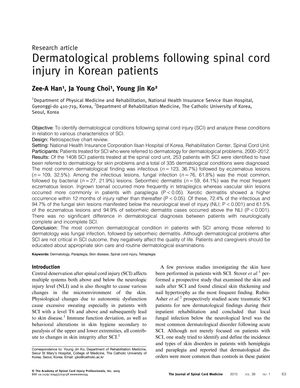Dermatological Problems Following Spinal Cord Injury in Korean Patients
October 2013
in “
The Journal of Spinal Cord Medicine
”

TLDR Most spinal cord injury patients in Korea experience skin problems, especially fungal infections and eczema, affecting their quality of life.
The study, conducted over a 12-year period on 1408 spinal cord injury (SCI) patients, identified 335 dermatological conditions, with fungal infections (36.7%) and eczematous lesions (32.5%) being the most prevalent. Fungal infections were more common below the neurological level of injury (NLI), while eczematous lesions, including seborrheic dermatitis, were more frequent above the NLI. Ingrown toenails were more often seen in tetraplegics, and vascular skin lesions were more prevalent in paraplegics. Xerotic dermatitis was particularly common within the first year post-injury. The study concluded that dermatological issues, while not critical to SCI outcomes, negatively affect quality of life and highlighted the importance of skin care education and routine dermatological exams for SCI patients. The study's limitations included its retrospective design, absence of a control group, and the inclusion of only patients referred to dermatology, but its large sample size lent significance to the findings. No significant difference in dermatological diagnoses was found between patients with neurologically complete and incomplete SCI.
